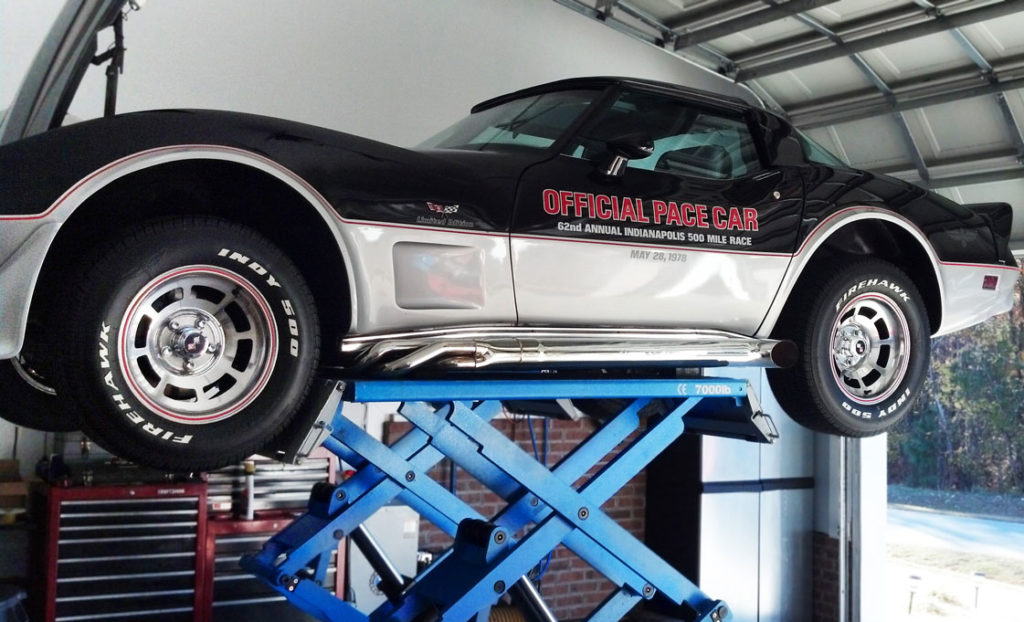All Posts
Auto Lifts: Choosing the Right Lift for Your Shop
If you’re going to service vehicles, you’ll need a way to get them off the floor. In the past, in-ground lifts were the most common, but today that has changed. In fact, there are seven different lift types (tested and certified by the Auto Lift Institute). How do you determine which lift type or combination of lift types is right for your particular needs? It all starts with a better understanding of your options.
Two-Post Surface Mounted Lifts

Once a rarity, two-post surface mounted lifts are now the most commonly used type in the US. This is because they can raise a large variety of vehicle types, but take up less room in the shop than a four-post lift, or other types. A two-post lift is bolted to the shop floor, and uses an electric motor to power a hydraulic system responsible for raising vehicles in most cases. Two swing arms are attached to each upright – they swing out under the vehicle, and adjustable feet are used to engage the frame, or support the subframe depending on the type of vehicle being serviced. Many two-post lifts come equipped with a top-mounted shutoff bar that ensures vehicles cannot be raised beyond a certain point for safety.
Four-Post Runway Lifts
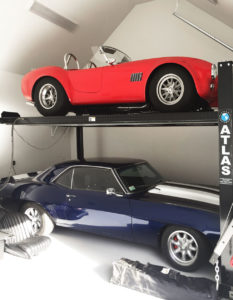
Four-post runway lifts are becoming pretty popular today, as well. They are usually bolted to the floor, and offer the ability to drive up and then drive off for service, rather than requiring the mechanic to position arms beneath the vehicle. In most cases, these lifts use the vehicle tires to support the car, which makes them ideal for use in situations where you only need access to the undercarriage, but do not need to remove wheels for any reason. However, they can be equipped with wheels-free systems that allow the wheels to be removed for brake work, tire replacements, suspension and steering service, and other work.
Drive-On Parallelogram Lifts
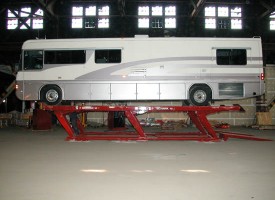
Drive-on parallelogram lifts are interesting – they share the drive up functionality of runway lifts, but require the vehicle to be backed off when work is done. However, some can offer two runways, allowing vehicles to be driven up, and then driven off, rather than reversing them. They’re often found in use as alignment lifts, and can be equipped with tire adjustment plates for that purpose specifically. Due to their significant strength and larger size, these lifts are frequently used when servicing larger, heavy-duty vehicles.
Scissor Lifts
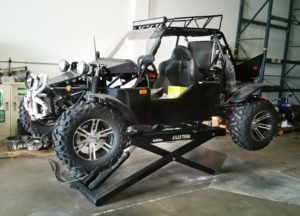
Scissor lifts have become increasingly popular in recent years, and you’ll find them in use in a range of different service types, including oil changes, tire replacement, in alignment bays, and more. This is because they can be equipped to be frame-engaging for wheels-free service, or they can support the vehicle by the wheels. While they work similarly to parallelogram lifts, scissor lifts do not move the vehicle forward or backward while raising or lowering – they move straight up and down. You can also purchase surface-mounted varieties, or you can choose an in-ground version. In-ground scissor lifts are often used for servicing heavy-duty vehicles, while surface-mounted versions are better suited to consumer grade vehicles.
In-Ground Lifts
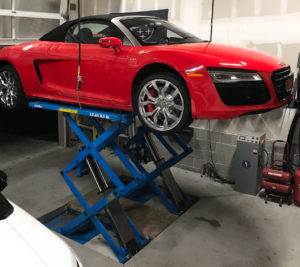
Once the most prominent type of vehicle lifts, in-ground lifts have become less popular with the rise of lighter, more adaptable configurations, such as two-post and four-post, floor-mounted varieties. In-ground lifts generally have most of their components located under the shop floor in a special enclosure, which requires different planning and construction steps. You’ll find a host of different lift types in this subcategory, including post type lifts, scissor style lifts and more, depending on the weight rating of the lift. Most of those designed for heavy-duty work use two or three pistons or scissors to ensure stability and strength. While in-ground lifts might require the most planning and significant site prep for installation, they are available in the widest range of styles and can be configured to suit the needs of just about any automotive shop.
Wheel Engaging Mobile Units
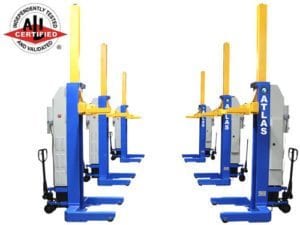
Need the ultimate in flexibility and configuration options? Plan to service a host of different vehicle types? If either of those is the case, you’ll want to at least consider wheel engaging mobile units, also called mobile column lifts. Interestingly, these lifts are completely mobile and are not tied to any single location. They generally have wheels located on the back, allowing them to be rolled to a new location for use. They are used in pairs (two, four or six, generally), and can be used with everything from consumer-oriented vehicles to heavy-duty vehicles, buses and emergency vehicles. While these lifts can be positioned to suit any vehicle setup, they do require a hard, level surface beneath them for stability.
Low and Mid-Rise Frame Engaging Lifts
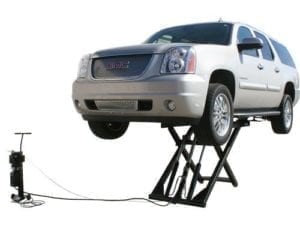
Depending on the type of shop you’re setting up, you might benefit from using a low or mid-rise frame engaging lift. These can be parallelogram or scissor style lifts, and they generally engage the frame or subframe of the vehicle, offering outstanding stability. However, because of their low level of rise, they are usually used for services that require only having the wheels off, such as tire changing stations, for brake work, or for body repair. Accessing the vehicle’s undercarriage is very difficult with this lift style, so they are not frequently used in shops where access to the drivetrain, oil pan, exhaust or transmission might be necessary.
Making Your Choice
As you can see, there are quite a few lift choices out there. Most shops will benefit from using a combination of different lifts based on their anticipated service needs. However, for a lift type that offers something of the best of all worlds, a two-post, floor-mounted lift may be the better choice. With that being said, it’s important to carefully analyze your needs, your available space, your anticipated vehicle types, and your budget, and then make an informed decision.

